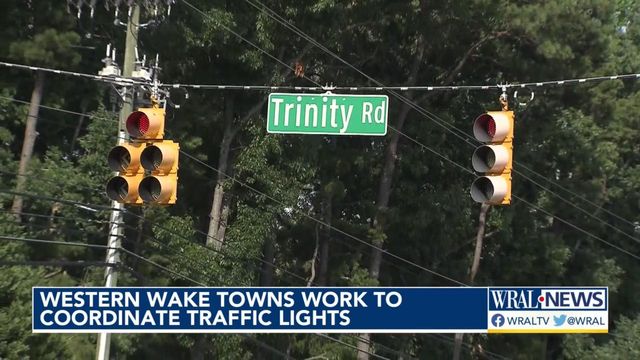Study considers giving green light to coordinating stop lights, shortening drives in Wake County
Driving up on red light after red light is a reality for some living in the Triangle. A new study is looking at ways to coordinate signals across five towns in western Wake County to speed up the commute and cut down on the stop-and-go nature of the average person's drive.
Posted — UpdatedA new study is looking at ways to coordinate signals across five towns in western Wake County to speed up the commute and cut down on the stop-and-go nature of the average person's drive.
If all five towns agree, there could be a central traffic center that could control the timing of your commute and coordinate signals for multiple systems throughout the western half of the county. The center would impact traffic on roads like NC Highway 54, which crosses through several towns. A representative could hit a button in the hub and adjust the timing on all the lights along the road at once.
The project's projected cost would be anywhere from $41.3 to $51.1 million over a 10-year span. But there could be numerous benefits for Fuquay-Varina, Holly Springs, Apex, Cary and Morrisville. The project would involve coordinating more than 400 traffic signals.
The full implementation would be 10 years away.
NC Capital Area Metropolitan Planning Organization (CAMPO) Deputy Director Alex Rickard described the factors for drivers like reduced stops, less delays, reduced travel times along the corridor and safety improvements when it comes to crash rates and pedestrian and cyclist activity.
"For taxpayers, there’s a benefit because any time we can sort of partner with other municipalities in the area, you see a reduction in cost for implementation," Rickard said.
There also could be shortened response times for emergency responders. The project could be big for an area growing at the rate Wake County is, considering that it's difficult to build roads quickly enough to keep up with growth.
"It’s trying to squeeze every bit of capacity we can out of the existing roadway network so we can delay having to widen the road or build a new road which is far more costly and often takes far more time." Rickard said.
A similar system that runs through a parkway in Orange County, California, reduced the number of stops by 75 percent and travel times by 11 percent.
Cary currently has an integrated traffic management center that speed up congested intersections through its control of more than 220 traffic lights. Cary manages its own signal system and some in Morrisville.
"We’re able to monitor traffic as it occurs live during the day," said Cary Transportation Director Jerry Jenson. "I don’t know what we would do as a community without it now. It’s been that much of a gamechanger for us to efficiently manage traffic."
Drivers can review the study and comment on it through Aug. 16. Then, CAMPO’s board will consider whether to go after federal funding for the system.
"At a regional level, you might see lower fuel consumption. You might see greenhouse gas reduction," Rickard said
• Credits
Copyright 2024 by Capitol Broadcasting Company. All rights reserved. This material may not be published, broadcast, rewritten or redistributed.





